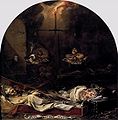Juan de Valdés Leal
Juan de Nisa Valdés Leal (born May 4, 1622 in Seville , † October 15, 1690 ibid) was a Spanish painter and sculptor of the Baroque .
biography
Valdés Leal, son of the Lusitan Fernando de Nisa and his wife Antonia de Valdés Leal from Seville, first learned the handicraft from 1637 in his hometown from Juan del Castillo , possibly also from Francisco de Herrera , who shaped his later painting style significantly.
On the advice of Antonio Palomino , he went to Cordoba in 1647 with his wife Isabel Martín de Morales, who was married on July 14 of the same year, and studied there with Antonio del Castillo y Saavedra until 1653 . He also got in touch with other important painters of the time, including Bartolomé Esteban Murillo . His first known pictures were created in Córdoba in 1652. Because of the plague that was prevalent in the city, the young family returned to Seville, returned to Córdoba again in 1654 and finally settled in Seville again in 1656 after the completion of the work that had begun in Córdoba. In 1654 Luisa Rafaela was born as the first and in 1657 Eugenia María as the second child of the family. In 1660 Valdés Leal became a member of the Academy for Painting, newly founded by Murillo and Herrera el Mozo, and then headed it himself from 1663 to 1666. In the meantime, Lucas was born in 1661, the first son of the family, who also went down in art history as a painter and graphic artist. In 1664 and 1667 his daughters María de la Concepción and Antonia Alfonsa were born.
Valdés Leal's paintings still adorn many cathedrals, monasteries, churches and hospitals today. After Murillo, Valdés Leal is now considered the most important painter in Seville.
gallery
Web links
Individual evidence
- ↑ Juan de Valdés Leal (Spanish), Biografías y Vidas.
- ↑ Juan de Valdés Leal (Spanish).
- ^ Valdés Leal, Juan De (Spanish), arteHistoria , Junta de Castilla y León.
| personal data | |
|---|---|
| SURNAME | Valdés Leal, Juan de |
| ALTERNATIVE NAMES | Nisa Valdés Leal, Juan de |
| BRIEF DESCRIPTION | Spanish painter and sculptor |
| DATE OF BIRTH | May 4, 1622 |
| PLACE OF BIRTH | Seville |
| DATE OF DEATH | October 15, 1690 |
| Place of death | Seville |








